News 2013
nuSPIC: Neural Systems Prediction and Identification Challenge: Scientists from Freiburg present an online tool to create and analyse neuronal networks
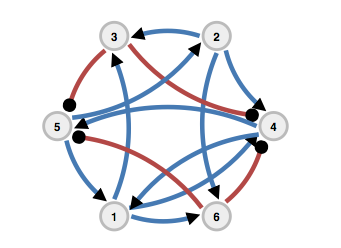
27.12.2013: Can we infer the function of a biological neural network if we knew the connectivity and activity of all its constituent neurons? This question is at the core of neuroscience and we believe that connectivity and activity are sufficient to address this question. In fact, this belief is the main impetus behind the development of ever more powerful methods to record the activity and connectivity of as many neurons as possible. Surprisingly, there is no theoretical or computational demonstration that neuronal activity and connectivity are indeed sufficient to infer the function of a biological neural network.
Article in "Science": Memories Are ‘Geotagged’ With Spatial Information

03.12.2013: Using a video game in which people navigate through a virtual town delivering objects to specific locations, a team of neuroscientists from the Universities of Freiburg and Pennsylvania has discovered how brain cells that encode spatial information form “geotags” for specific memories and are activated immediately before those memories are recalled.
A novel view on the visual cortex: Theoretical model explains properties of sensory neurons and networks
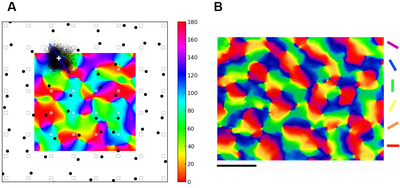
28.11.2013: Almost forty years ago, David H. Hubel and Torsten N. Wiesel won the Nobel Prize in Physiology or Medicine for their seminal work on the neuronal mechanisms of vision. One of their groundbreaking findings was that they identified orientation selective neurons in the primary visual cortex (V1) as an essential building block of visual perception. In the visual cortex of cats, the researchers found neurons that prefer a specific orientation of a light bar over all the others. They concluded that these neurons could act as edge detectors. This property arises in the cortex for the first time; neurons in the retina and in the lateral geniculate nucleus (the relay station between the retina and V1), still respond equally to all orientations.
Young researchers from Freiburg accepted in Network of European Neuroscience Institutes

16.10.2013: Since October, Freiburg is a member of ENI-NET, the highly reputed Network of European Neuroscience Institutes
Embedded nerve cells hold the key to brain activity: Scientists from Freiburg propose new approach to unravel the function of the human brain
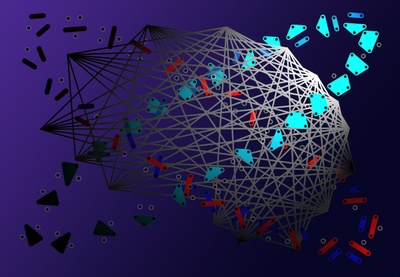
24.07.2013: Understanding complex systems such as the brain of mammals: Arvind Kumar and colleagues from the Bernstein Center and the Cluster of Excellence BrainLinks-BrainTools at the University of Freiburg present a new view on brain function. Much of today’s brain research follows an approach that has been in use for decades: An area of the brain is either silenced of augmented in its activity, and the resulting effects in other parts of the brain – or in the whole organ – are measured. While this approach is very successful in understanding how the brain processes input from our senses, a team of scientists from Freiburg argues that it is too simple when trying to understand other brain regions. The team presents their findings in the current issue of the journal “Trends in Neuroscience”.
New approaches in Parkinson’s research: Joint research between Freiburg and Jerusalem receives funding

23.07.2013: Scientists from Freiburg and Jerusalem received a three-year grant by the German-Israeli Foundation for Scientific Research and Development (GIF). The money is awarded for the team’s research into the causes of mental symptoms in Parkinson’s disease.
European funding for Freiburg’s epilepsy research: Newly developed method will shed light on causes of the disease
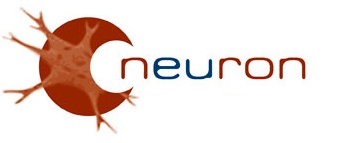
10.07.2013: An international group of researchers from Freiburg, Berlin, Paris and Helsinki has received a grant over 1.6 million € by the European Union. Their goal is to develop novel approaches that will help to identify the molecular mechanisms underlying not only disease-promoting but also adaptive mechanisms triggered during the initial stages of epilepsy. “This information will let us test specific strategies to block processes that are crucial when epilepsy arises,” as Carola Haas, Freiburg’s principal investigator of the project, points out. The project will be funded over the course of 3 years.
Science Fair 2013

01.07.2013: Joint exhibits of the Bernstein Center Freiburg and the Cluster of Excellence BrainLinks-BrainTools.
Mapping the Brain: Freiburg Researchers Use Signals from Natural Movements to Identify Brain Regions
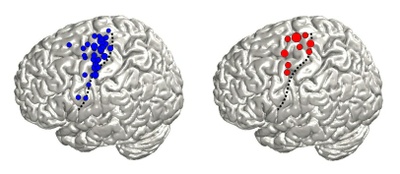
06.06.2013: Whether we run to catch a bus or reach for a pen: Activities that involve the use of muscles are related to very specific areas in the brain. Traditionally, their exact location has only been determined through electrical stimulation or unnatural, experimental tasks. A team of scientists in Freiburg has now succeeded for the first time in mapping the brain’s surface using measurements of everyday movements.
The beating heart in your brain: Scientists from Freiburg investigate how our brain senses the beating of our own heart

05.06.2013: Everyone knows the sensation of feeling the own heart beating – be it because you speak for the first time to the love of your life, or you give a speech in front of a big crowd, or sprint to reach a bus and are out of breath. Although investigation of how the brain controls and processes such heart activity has become a prominent topic in recent years, the question remained unresolved which brain structures are responsible for the sensation of the “beating heart”. Particularly the cardiac field artifact (CFA) that originates from the myocardial muscle contaminates electroencephalography (EEG) recordings and handicaps electrophysiological research in this direction, masking the true heart beat-related brain responses.
Details of connectivity play important role for network activity

04.06.2013: Simulating a large variety of different networks, BCF scientists systematically evaluate which features in their structure most strongly affect their dynamics.
Science Jam Nr. 1: Ein bunter Abend mit Seh- und Hörforschern

06.05.2013: Wissenschaft lebt vom Experimentieren. Viele Entdeckungen geschehen, wenn unterschiedliche Dinge zusammentreffen und auf unerwartete Weise miteinander reagieren. Dieses Prinzip greifen die „Science Jams“ auf: Die neue Veranstaltungsreihe des Bernstein Center Freiburg und des Exzellenzclusters BrainLinks-BrainTools der Universität Freiburg präsentiert Wissenschaft in ungewöhnlichen Zusammenhängen – weitab von Hörsälen und Seminarräumen.
Stimulating research
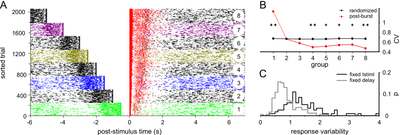
23.04.2013: Scientists explore how spontaneous and evoked activity in the brain’s network of nerve cells interact
Zittern in Zahlen: Artikel in Gehirn und Geist [German]
![Zittern in Zahlen: Artikel in Gehirn und Geist [German] Zittern in Zahlen: Artikel in Gehirn und Geist [German]](https://bcf.uni-freiburg.de/news/2013/20130405-gug/@@images/8385177c-49c7-42f1-beaf-405d674c473d.png)
05.04.2013: Arvind Kumar und Gunnar Grah vom Bernstein Center Freiburg und BrainLinks-BrainTools beschreiben in der aktuellen Ausgabe von "Gehirn und Geist" die Erforschung der Parkinson-Krankheit mithilfe von Computermodellen.
‘Brain waves’ challenge area-specific view of brain activity

21.03.2013: Our understanding of brain activity has traditionally been linked to brain areas – when we speak, the speech area of the brain is active. New research by an international team of psychologists led by David Alexander and Cees van Leeuwen (Laboratory for Perceptual Dynamics), including researchers from the Bernstein Center and BrainLinks-BrainTools at the University of Freiburg, shows that this view may be overly rigid. The entire cortex, not just the area responsible for a certain function, is activated when a given task is initiated. Furthermore, activity occurs in a pattern: Waves of activity roll from one side of the brain to the other.
No two cells act the same

13.03.2013: Using mathematical theory, scientists discover effects of differences among neurons in the brain
"Dynamics of Neuronal Systems"
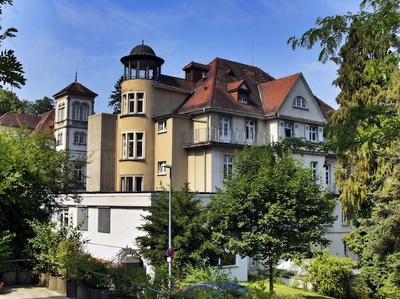
13.03.2013: Bernstein Center Freiburg hosts conference on March 18-20
Let the neuron do the work! Using membrane potentials, scientists devise a novel method to infer dynamic interactions among groups of neurons
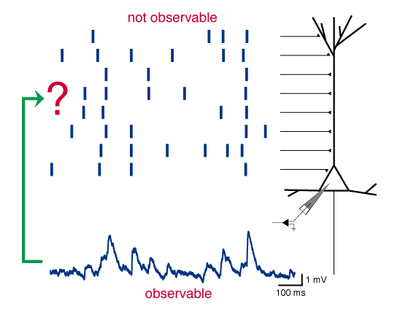
10.03.2013: Our understanding of how the brain processes and transmits information is still sketchy at best. One thing is clear however: neurons do not act in isolation. Rather, they need to join forces and emit their action potentials, or spikes, in a coordinated fashion to be effective. How exactly this is done in the brain remains elusive though. Neurons could operate either in small groups or in huge populations, their coordinated action could be very precise in time or rather sloppy. Advanced methods of data analysis can help to gain new insight into these and related questions, and it is indispensable to develop and apply new such tools that are both effective and reliable.
Reconstructing networks from spike train data: For networks with sparse connectivity, the underlying structure can be inferred from measured correlations
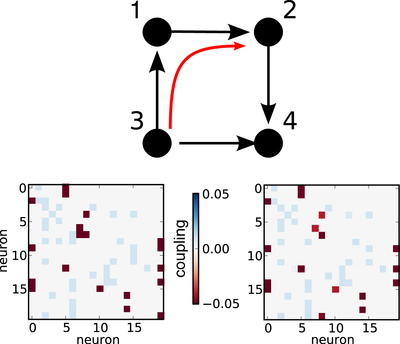
10.03.2013: The relation between causation and correlation is often difficult to assess: Just because things happen close by in time or space does not mean that there must exist a causal relationship between them. Neuroscientists have to deal with this problem when they try to infer physical synaptic connections between neurons from measured correlations in their activity. Specifically, they look at the sequences of brief electrical impulses, so-called spike trains, through which most of the communication between neurons in the nervous system happens. A major obstacle is that shared presynaptic neurons, as well as other indirect links between neurons, can cause correlations, even if no direct connection is present.
Neuroscience at the Science Slam
28.01.2013: BCF's PhD student Tiago Felix made second place at the Freiburg Science Slam on January 28. A videocast of the evening is now online.
TIGER roaming the Rhine valley: Trinational initiative aims to find causes for neurological diseases

20.02.2013: The Bernstein Center Freiburg hosts a new project, strenghtening the research of neurological diseases from the perspective of theoretical neuroscience. Within the “Trinationale Initiative Gehirnerkrankungen” (TIGER – Trinational Initiative on Brain Diseases) scientists from Freiburg, Strasbourg/France and Basel/Switzerland investigate the neuronal networks involved in several brain diseases. They place special emphasis on such conditions as movement disorders, epilepsy, and anxiety. The research initiative has a budget of almost € 1.4 million, with half of the amount being contributed by the European Union.
New Probes for the Brain: The Department of Microsystems Engineering of the University of Freiburg is coordinating the research project NeuroSeeker

13.02.2013: Developing tiny probes for research and brain-related medical applications – that is the goal of the project NeuroSeeker, launched in February 2013 with a kick-off event in Leuven, Belgium. The interdisciplinary project pools the expertise of ten partner institutions from Europe and Canada. The University of Freiburg will receive around 1.7 million euros from the European Union (EU) in the coming four years for its contribution. The project coordinator is Dr. Patrick Ruther, who works under Prof. Dr. Oliver Paul at the Microsystems Materials Laboratory of the University of Freiburg’s Department of Microsystems Engineering (IMTEK). Other University of Freiburg researchers involved in the project are Prof. Dr. Ulrich Schwarz, IMTEK Chair of Optoelectronics, and Prof. Dr. Stefan Rotter, Bernstein Center Freiburg.
Learning from mistakes: Scientists identify error signals and help to improve movement detection for brain-machine interfaces

01.02.2013: Brain-machine interfaces (BMIs) translate the activity of nerve cells that accompany a user’s movement intention into action, for instance that of a robotic arm. In spite of continuous improvements, errors that are made while the computer tries to decode an intended movement still pose a major problem for current BMI systems. If the decoded movement veers off noticeably from the intended movements, scientists call this an “execution error”. Another type of error that is important to consider with BMIs is the so-called outcome error. In this case, a subject fails to reach a certain movement goal (for instance, securely grasping a cup). Operating BMIs would greatly benefit from detecting such errors: The computer could correct them after detecting that intention and execution do not match any more. And furthermore, an adaptive BMI decoding algorithm could update itself and learn to avoid such errors in the future.
A Light Switch inside the Brain: Scientists from Freiburg Build a Microimplant that Uses a Laser to Control Individual Nerve Cells
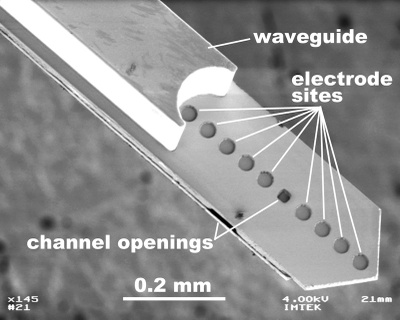
18.01.2013: ndividual Nerve Cells Activating and deactivating individual nerve cells in the brain is something many neuroscientists wish they could do, as it would help them to better understand how the brain works. Scientists in Freiburg and Basel, Switzerland, have developed an implant that is able to genetically modify specific nerve cells, control them with light stimuli, and measure their electrical activity all at the same time. This novel 3-in-1 tool paves the way for completely new experiments in neurobiology, also at Freiburg’s new Cluster of Excellence BrainLinks-BrainTools.

